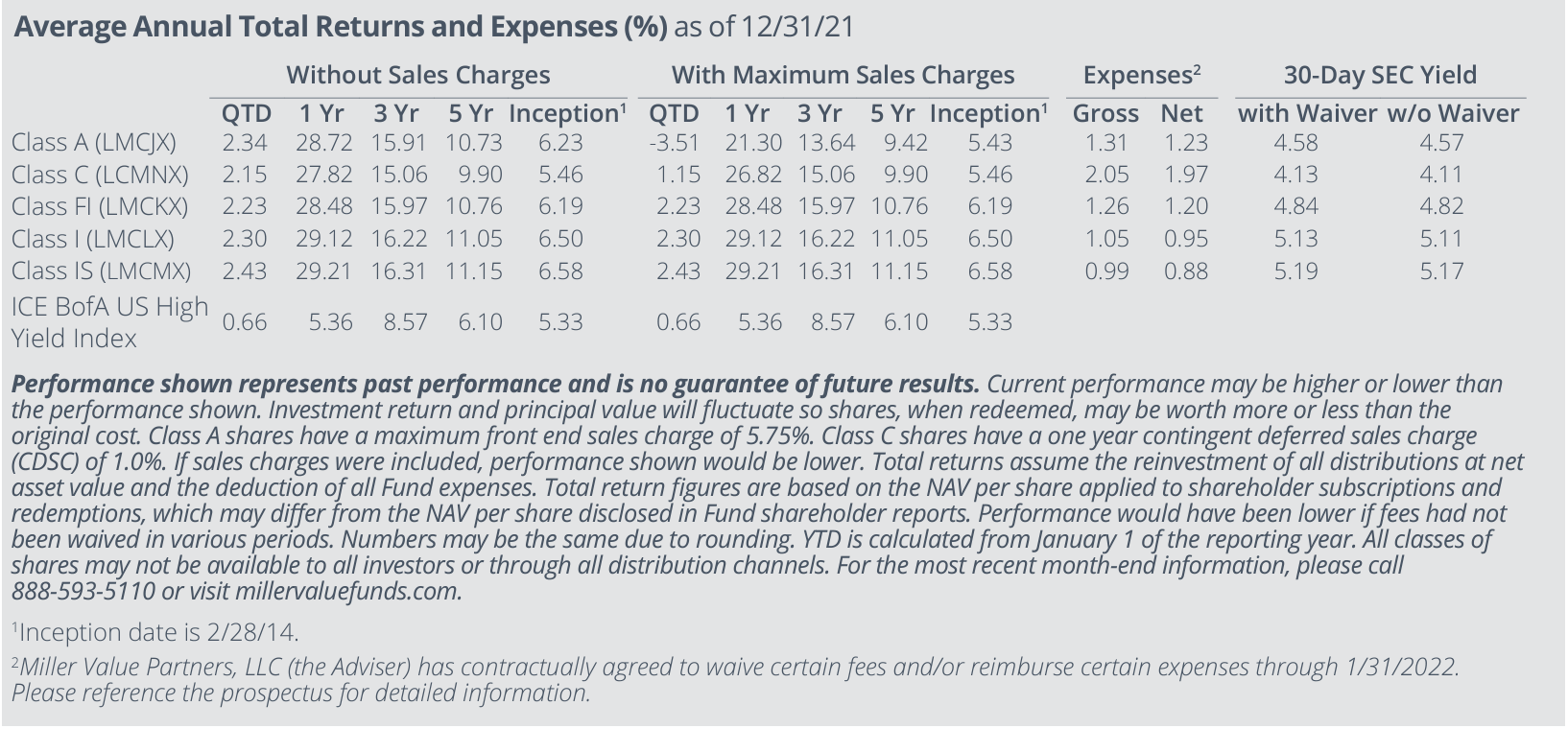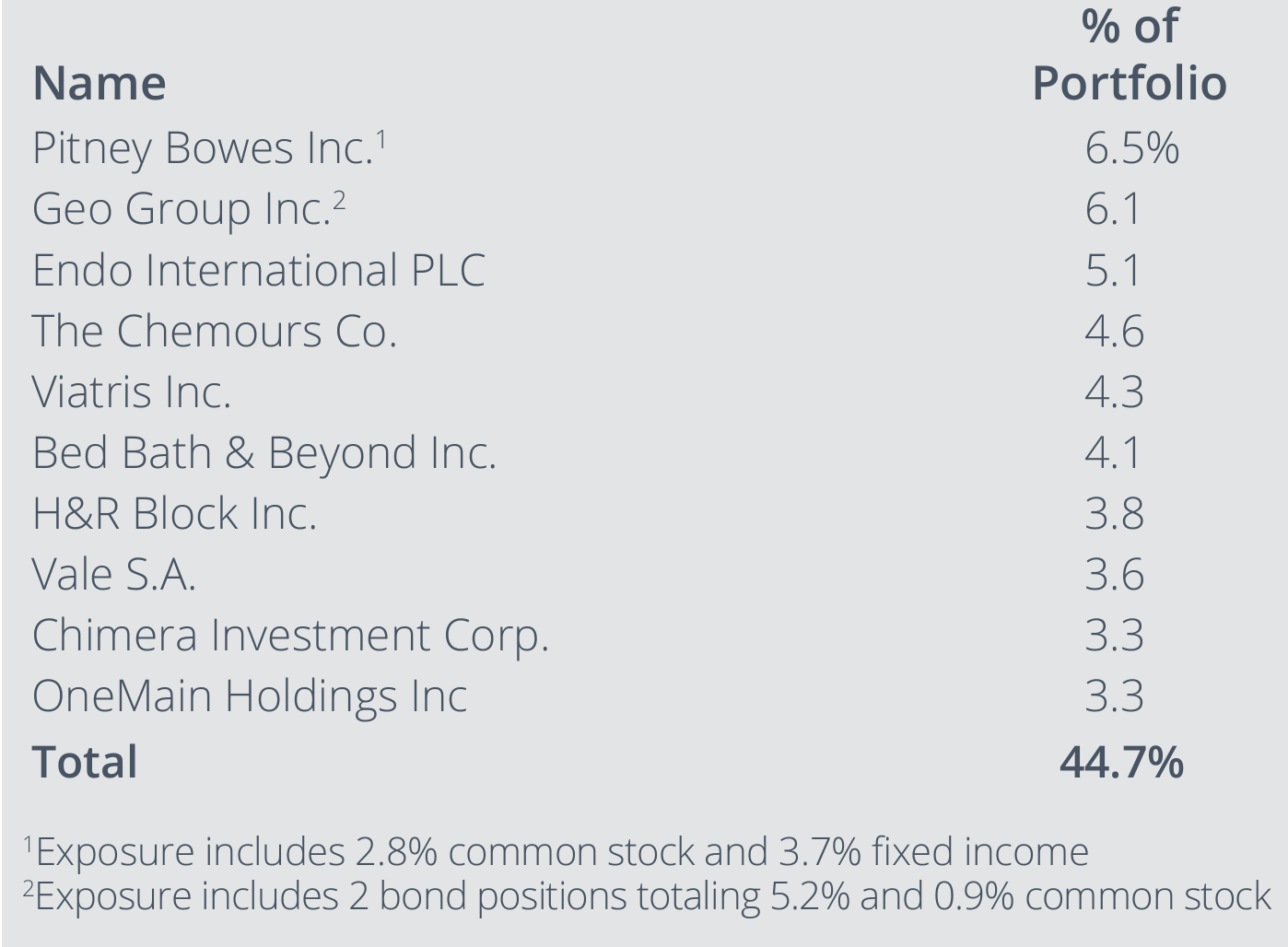Miller Income Fund 4Q 2021 Manager Letter
The Miller Income Fund (Class I) returned 2.30% in the fourth quarter of 2021 versus 0.66% for its benchmark, the ICE BofA US High Yield Index. Since the Strategy’s inception, we designed it to provide a functional benefit—namely, a high level of income while maintaining flexibility to navigate a variety of investing environments. Though the lack of constraints around asset classes presents a hurdle for investors who want to operate in neatly constrained style boxes, it is proving especially important today with inflation hitting a 40-year high of 7% in 2021.

In previous shareholder letters, we have often noted that diversified fixed income is not a great place to be when held up against the macroeconomic data and valuations. Last year’s returns substantiate this perspective. In 2021, the high-yield index did a 5.36% total return. However, it is not possible to invest in the index, as it represents a collection of 2,123 different bond issues, many of which do not trade often enough to buy. The two most liquid passive high yield ETFs returned between 3.75% and 3.99% last year. Not only are these returns significantly worse than the index, but these ETFs, as well as the index, all returned less than the inflation rate in 2021, meaning that those invested in these assets lost purchasing power by owning them last year; for most people, losing purchasing power in a supposedly “safe” asset – bonds – is not the name of the game.
Investors appear to be waking up to the reality that the contextual backdrop for fixed income has not improved all that much. On the first trading day of 2022, over a billion dollars came out of the iShares long-dated treasury ETF (TLT), almost 7% of the entire fund, representing the third-biggest outflow in its nearly 20-year history. High-yield ETFs are also seeing very large outflows. Still, neither government bonds nor diversified high yield are assets we want to own. The ten-year US government bond yields just 1.74% today, so if you own the ten-year bond and its valuation does not change over the next year, your purchasing power will go down by approximately 5% if inflation remains at the current level. Our high-yield benchmark is priced to yield 4.5%, so if there are no defaults and no fees, a holder will lose approximately 2.5% per year in purchasing power if inflation stays at 7%.
The key question now is, “Will the inflation be transitory, or can the Federal Reserve still rein it in?” The best starting point from which to consider this is the bond market’s current expectations, which are for the Fed to indeed stick the landing; in other words, the market thinks that inflation is most likely to recede over the coming years and be close to 2% annually in five years. Perhaps it is the huge collection of assets sitting on the Fed’s balance sheet providing the market comfort that a path to quickly remove liquidity exists if need be.
Though the market thinks the Fed has everything under control, it is possible that the Fed underestimates the reflexivity of the demand response to all the monetary and fiscal stimulus. They have signaled their intention to continue dumping liquidity into the market for another few months even with inflation hitting a 40-year high and unemployment approaching previous lows. The flipside to the Fed’s unprecedented asset holdings is that the Fed is not an economically motivated buyer, which means that their massive influence on the bond market is likely distorting pricing signals.
Why do we pay so much attention to the Fed? Because they are the driving marginal influence on the “risk free” rate, or the cost of capital off of which asset prices derive. Monetary policy is an immensely powerful and flexible tool which helps set the course for the economy. We focus on the Fed so our shareholders don’t have to, as our strategy provides flexibility to source what we believe are the most compelling opportunities for income across the capital structure based on valuation. This means it is important to understand not only the mechanics behind varying capital costs, but also how the mechanics are likely to impact the cash flows our holdings will likely generate. Over the past few quarters, we have cut back on bonds where the investment thesis had a lot to do with relative valuation disparities and replaced them with holdings where we think the cash flows and distributions are likely to grow with the economy.
As always, we remain the largest shareholders of the fund, and we appreciate our fellow shareholders’ support, questions and comments.
Top 10 Holdings by Issuer as of 12/31/21

Top Contributors
- Preferred Apartment Communities (APTS) was the top contributor over the quarter, advancing 49.5%. The company reported Q3 Funds from Operations (FFO) of $0.28, nicely ahead of consensus of $0.17, and the quarterly dividend of $0.175/share (4.0% annualized yield), driven by higher net operating income (NOI). Multifamily same-store revenue rose +7.5% year-over-year (Y/Y) with same-store NOI +8% and occupancy improving to 97.1%. Management raised Fiscal Year 2021 (FY21) FFO guidance by 8.9% at the midpoint to $1.00-$1.07. The company continued its asset recycling strategy over the period with the announced sale of an office property in Alabama for $55M.
- The Chemours Co (CC) rose 16.4% over the period after reporting Q3 revenue of $1.68Bn, +36% Y/Y and +4% ahead of consensus driven by 25% volume growth while pricing added +11%. Earnings Before Income, Taxes, Depreciation, and Amortization (EBITDA) of $372M rose +77% and beat estimates by 9% as higher top-line results more than offset incremental cost headwinds. Chemours raised FY21 guidance, including EBITDA of $1.3Bn-$1.34Bn (from $1.1Bn-$1.25Bn), Earnings Per Share (EPS) of $3.93-$4.13 (from $2.84-$3.56), and free cash flow (FCF) of at least $500M (from >$450M). Additionally, Chemours announced the closing of the previously announced sale of the Mining Solutions business for $520M.
- Apollo Global Management (APO) rose 18.4% during the quarter. The company reported Q3 distributable earnings (DE) of $1.71, well ahead of consensus of $1.10 and the quarterly dividend of $0.50/share (2.8% annualized yield). Fee-related earnings of $300M beat by 7% while realized net performance fees of $312M topped estimates by 23%. Total assets under management (AUM) of $481.1Bn and fee-earning AUM of $361.3Bn both rose +2% sequentially on the back of robust capital raising with $18.1Bn of inflows over the period. Additionally, Apollo hosted their 2021 Investor Day, outlining long-term financial targets including over $9/share in distributable earnings by 2026 (14% Compound Annual Growth Rate (CAGR) from $5.50 pro-forma 2022E) and fee-related earnings of $4.50-$4.75 (18% CAGR). Management expects to roughly double AUM by 2026 to $1trn from $481Bn currently with a 2.25x increase in fee-related revenues to $4.6Bn.
Top Detractors
- Sculptor Capital Management (SCU) was the top detractor over the quarter, falling 22.5% despite reporting solid Q3 results. The company reported Q3 distributable earnings of $0.58, ahead of consensus of $0.52 driven by incentive income of $27M and lower compensation expense. Accrued incentive income rose 13% to $252.6M on strong quarterly performance while net flows totaled $417M. The company declared a quarterly dividend of $0.28/share (5.2% annualized yield).
- Sberbank (SBER LI) declined 14.7% during the period despite posting a Q3 beat and FY21 guidance raise. Sberbank reported Q3 net profit of RUB 348Bn, +28% Y/Y and ahead of consensus by 3% for a Return On Equity (ROE) of 26.8%. Net interest income of RUB 470Bn beat consensus on net interest margin of 5.36% (+14bps quarter-over-quarter (Q/Q)) while net fee and commission income of RUB 164Bn remained solid on growth in bank card operations. Management raised guidance for FY21 ROE to over 23% (from 22%). Additionally, the company hosted an investor event on their mortgage business, highlighting their expectation to deliver a 15%+ CAGR from 2021-2023 in the lending portfolio while also maintaining over 50% market share. Shares dropped, however, in sympathy with Russian indices after the US warned its European Union allies that Moscow may be weighing a potential invasion of Ukraine.
- OneMain Holdings (OMF) dropped 8.4% over the period. The company reported Q3 EPS of $2.37, +9% Y/Y and ahead of consensus of $2.30 driven by interest income of $1.1Bn and a portfolio yield of 23.77%. Originations of $3.9Bn rose +34% Y/Y, driving end of period receivables to $18.9Bn while net charge-offs of 3.5% improved 167bps. Management maintained FY21 strategic priorities, including managed receivables growth of 8%-10%, a stable yield (>24%), and net charge-offs of 4.2%. Additionally, the company repurchased $100M of stock as part of Apollo Global Management’s 10.01M secondary offering while also increasing their current buyback authorization to $300M (from $200M).
